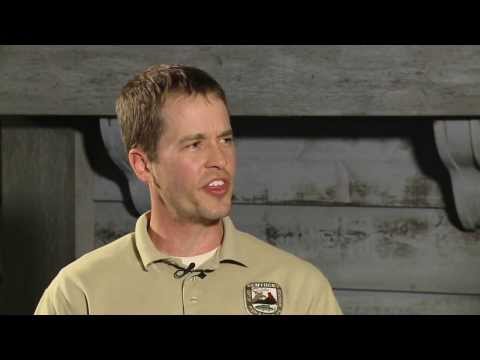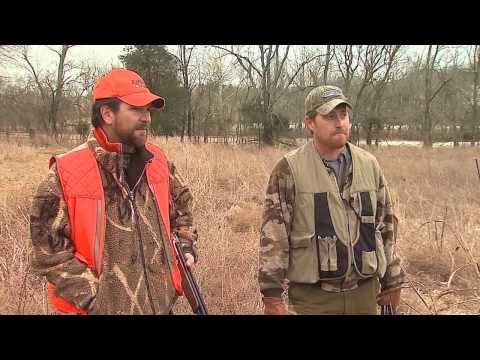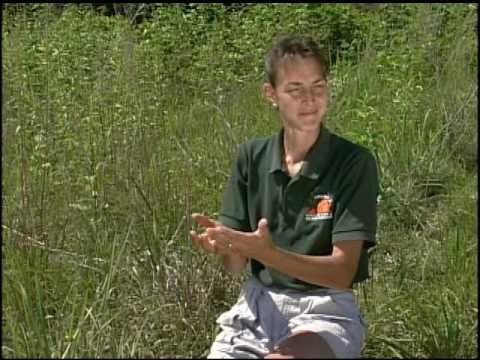
Talking Quail with Biologist Ben Robinson
Find out what you can do to help increase the population of quail on your farm. Small Game Biologist Ben Robinson joins us to educate

Find out what you can do to help increase the population of quail on your farm. Small Game Biologist Ben Robinson joins us to educate

The Kentucky Afield crew heads to Boyle County on the last day of quail season.

The distinctive “Bob-White!” call of the quail is becoming just a memory for many rural Virginians. Quail populations in Virginia have declined 80% over the

Interview with Mr. Gillingham, private land enhancements
National Bobwhite Conservation Initiative (NBCI) efforts to restore wild bobwhites across their historic range received a boost on the national stage recently when the Wildlife and Hunting Heritage Conservation Council (WHHCC) urged Interior Secretary Sally Jewell and Agriculture Secretary Tom Vilsack to essentially adopt NBCI’s strategies on lands they manage or influence.
The WHHCC is a federally appointed group advising both departments and is composed of national hunting, conservation, industry and shooting sports leaders. The council said adoption and support of NBCI’s approach would “proactively avert problems that have occurred with other declining game bird species like Lesser Prairie-Chicken and Greater Sage-Grouse.” The council said while multi-state plans had been crafted to deal with those species because of the fear of an endangered species listing, that same situation with bobwhites could be avoided by being proactive.
To reestablish bobwhites in their historic agricultural and forested settings, the council offered four strategies:
“…now is the time for federal actions to prevent future ‘listing anxiety’,” wrote John Tomke, council chairman. “Your departments have the opportunity to ensure the restoration of habitat for bobwhite quail, other declining grassland birds and pollinators on private croplands, rangelands and forest lands. In addition, many National Forests, National Parks, National Battlefields, Military Parks and National Wildlife Refuges are ideal places …”
“The council is spot-on when they say these federal agencies can have a huge impact on populations of bobwhites, other grassland birds and pollinators on both private and public lands,” said NBCI Director Don McKenzie. “We appreciate the council’s support and would welcome proactive participation by both the Interior and Agriculture departments.”
Headquartered at the University of Tennessee Institute of Agriculture’s Department of Forestry, Wildlife and Fisheries, NBCI is an initiative of the National Bobwhite Technical Committee (NBTC) to elevate bobwhite quail recovery from an individual state-by-state proposition to a coordinated, range-wide leadership endeavor. The committee is comprised of representatives of 25 state wildlife agencies, various academic research institutions and private conservation organizations. Support for NBCI is provided by the Federal Aid in Wildlife Restoration Program, state wildlife agencies, the University of Tennessee and Park Cities Quail. For more information, please visit www.bringbackbobwhites.org and find us on Facebook, YouTube and Slideshare.
 |
|
Michael Hook is the South Carolina Department of Natural Resources’ (SCDNR) new “quail coordinator” and Small Game Program Leader. Hook filled the position left by Willie Simmons, now a regional coordinator for the wildlife section. Hook will represent South Carolina on the National Bobwhite Technical Committee and play an active role in the National Bobwhite Conservation Initiative on behalf of the state,
Hook obtained a B.S. in Resource Management at Clemson University and worked as an SCDNR wildlife technician at Crackerneck Wildlife Management Area and Ecological Reserve for four years, then began a stint with the Aquatic Nuisance Species Program while earning his M.S. in Environmental Resource Management at the University of South Carolina. Following a decade as the program’s field supervisor he recently rejoined the Wildlife Section as the Small Game Program Leader overseeing the quail, dove, rabbit and fox squirrel projects.
“Every morning when I come into my office and I see that big quail poster on my door, I think to myself ‘This is my job, this is what I get to do today’ and I just have to smile,” said Hook. “To be able to get back into the wildlife field is exciting in itself but to get to work with quail, a passion of mine in the field , is really the icing on the cake. It just doesn’t get any better than making a career out of something you love.”
Michael is an avid outdoorsman who fishes and hunts for whatever is in season. He and his wife, Amanda, have a three-year-old son, Holden, and a Boykin Spaniel, Molly, who earns her keep retrieving ducks and doves, kicking up quail and woodcock, and keeping the backyard free of squirrels.
Hook can be contacted at (803) 734-3940.
Steve Chapman, a Certified Forester and a Georgia Registered Forester with 30 years of experience and a reputation of working closely with Georgia Wildlife Division biologists to create
 |
|
wildlife habitat in forested settings, has been selected as the new forestry coordinator for National Bobwhite Conservation Initiative (NBCI).
Chapman will promote NBCI’s forested grassland habitat objectives for bobwhites and other grassland birds at national, regional and state levels, including serving as a liaison and technical resource for state, federal and other conservation entities, engaging the U.S. Forest Service at regional and national levels to increase opportunities for bobwhite habitat projects and working to improve forest management and prescribed fire policies in support of forested grasslands habitat range-wide.
A graduate of the University of Georgia’s Warnell School of Forestry and Natural Resources with a B.S. in Forest Resources, Chapman worked with the Georgia Forestry Commission for 27 years before launching his own habitat management services company. Chapman is active in the Society of American Foresters, serves on the board of his local chapter of the National Wild Turkey Federation, was a principal in the development of the first Longleaf Academy, served on the Natural Resources Conservation Service’s (NRCS) State Technical Committee and was a member of the Southeastern Forestry and Wildlife Working Group.
“This is an amazing opportunity to be a part of something historic in wildlife conservation in this country and I’m excited to be a part of it,” said Chapman.
NBCI Director Don McKenzie said the role of the forestry coordinator is critical because NBCI has identified much of the potential for bobwhite habitat restoration to be on forested lands. “Our efforts in the forestry arena have already resulted in the formalization of the new Shortleaf Initiative as an independent entity, but we still have a lot more work to do to achieve our forest management-related habitat goals.
“For the first time in NBCI’s history we are fully staffed, all in positions identified as critical to our mission by the National Bobwhite Technical Committee. We now have a science coordinator, a communications director, an agriculture liaison in Washington, D.C., a grasslands coordinator, a spatial data analyst and now a new forestry coordinator…and some resources for them to be effective. This will allow us to pursue all of our habitat restoration strategies for wild bobwhites, especially the forest, grazing lands, cropland components, much more aggressively than before and be of greater value to the 25 NBCI member states,” McKenzie said.
Chapman, who will work from his office in Milledgeville, GA, can be contacted at schapm16@utk.edu or 478-451-9114.
About NBCI
Headquartered at the University of Tennessee Institute of Agriculture’s Department of Forestry, Wildlife and Fisheries, NBCI is an initiative of the National Bobwhite Technical Committee (NBTC) to elevate bobwhite quail recovery from an individual state-by-state proposition to a coordinated, range-wide leadership endeavor. The committee is comprised of representatives of 25 state wildlife agencies, various academic research institutions and private conservation organizations. Support for NBCI is provided by the Federal Aid in Wildlife Restoration Program, state wildlife agencies, the University of Tennessee and Park Cities Quail. For more information, please visit www.bringbackbobwhites.org and find us on Facebook, YouTube and Slideshare.
Area 51 is no match for the range-wide bobwhite decline as fodder for public speculation and skepticism of authority. Even as the most of the nation’s bobwhite experts are actively collaborating on the NBCI, applying the state of the science to develop and implement long-range, habitat-based solutions to begin restoring huntable populations, the president of an Arkansas energy company recently wrote a prominent op-ed in the state paper, asserting (without scientific evidence) his quail solution: reintroducing red wolves, cougars and bobcats. I appreciate that he cares enough about quail to write.
Subsequently, by coincidence of timing, that paper and others printed a spate of positive bobwhite articles and editorials, spurred mainly by a unique new partnership between the Arkansas Game and Fish Commission and the Pea Ridge National Military Park, to create the state’s first official NBCI quail focal area. AGFC’s emerging interest in bobwhite restoration had begun creating a buzz.
The state paper then published a second speculative bobwhite op-ed by the energy company president the week before last, reiterating that the authorities “are wrong about the loss of habitat, and I’m going to tell you, once and for all, why.” The entirety of his evidence:
“There are millions of acres in our state of good quail habitat without a single quail. A comparison between uncultivated acreage in the 1940s and today will show an actual increase in uncultivated acres, as the thousands of small farms of the ’40s, ’50s, and ’60s, were abandoned and the land was allowed to return to nature. If habitat loss were the primary cause, where are the quail that once were plentiful in those millions of acres?”
Already admitting that his original alternative theory may have been off the mark, he now asserts (again with no scientific evidence) that the major culprit in the long-term, state-wide bobwhite decline is feral hogs. His solution: stop funding habitat work, and use that money for hog bounties.
Such uninformed opinions would be just that and little more, except for (1) the overall frustrated, pessimistic and thus impressionable mindset of a broad spectrum of hunters and other bobwhite lovers; and (2) the paucity of compelling visible proof that adequate habitat restoration does work. This combination is ripe for the quail constituency (including hunters and key policy-makers) to either make poorly informed decisions or lose interest and give up entirely.
Meanwhile, the clock is ticking and bobwhites continue to decline. The authorities clearly have something to prove, the sooner the better.
The NBCI’s new (2014) Coordinated Implementation Program (CIP) is a science-based, methodical approach to bobwhite restoration success, designed to clearly demonstrate the connection between suitable habitats and increased bobwhite populations. A long name for the NBCI’s official focal area program, the CIP aims to increase the odds of habitat-based bobwhite restoration successes by (1) providing a framework for siting and designing focal and reference areas in prime locations, (2) requiring states to set meaningful and measurable population goals and habitat objectives, (3) setting near-term timeframes (5 to 10 years) for completion, and (4) requiring science-based standardized habitat assessments and bird population monitoring to document results.
An NBCI goal is for all 25 bobwhite states to have at least one official CIP focal area in the near future. At least 15 states already have or are actively in the process of establishing one or more CIP focal areas. Additional states are considering taking the CIP leap soon.
Establishing an aggressive, standardized and coordinated 25-state quail focal area program is a big challenge; implementing it
 |
|
effectively at local, state and national levels is even more so. The National Bobwhite Technical Committee (NBTC) – the brain trust behind the NBCI – along with the Kentucky Department of Fish and Wildlife Resources and the NBCI just completed a major CIP implementation task last week: sponsoring a train-the-trainer workshop for conducting CIP habitat assessments. About three dozen people from 14 states participated in the training at Shaker Village, KY, the site of one of the nation’s most dramatic and encouraging recent examples of habitat-based bobwhite restoration. (For more information about Kentucky’s 5-year benchmark study of their bobwhite restoration efforts, visit this link: http://goo.gl/6C8QRc.)
The NBCI hired a professional film crew to document the entire workshop and produce a series of online training modules, and now is surveying all participants for feedback and recommendations on other ways to help states move forward with CIP bobwhite restoration areas. Meanwhile, the NBCI’s new Data Analyst, Derek Evans, is on board at the University of Tennessee Institute of Agriculture’s Information Technology Services Department, with a top priority to develop the mechanisms and central databases to store, organize and analyze and report the states’ CIP data.
The history of bobwhite conservation over the past half-century is littered with the debris of failed (i.e., half-hearted, short-term, under-funded, inadequately staffed, poorly planned, unmonitored, etc.) quail initiatives and focal areas. Even if it is obvious to the professional bobwhite managers why those prior efforts came up short, every one of those failures exacerbates the public skepticism about habitat as the foundation of the problem, and undermines the authorities’ credibility. The bobwhite conservation world can afford no more publicly perceived failures.
The CIP will not allay the skepticism and speculation right away, but it is a thorough, scientifically based, adaptive management approach to bobwhite restoration across the species’ range, that increases our collective chances of successes, while providing hard data to help understand and explain when results vary from predictions. The potent show of support and effort for the CIP training last week at Shaker Village was a heartening indicator of the states’ and our partners’ seriousness and will to catalyze more bobwhite successes and minimize or eliminate failures.
We have something to prove.
The National Bobwhite Conservation Initiative (NBCI) has hired a researcher from Southern Illinois University (SIU) Carbondale, Derek Evans, as the program’s new data analyst. Evans will begin work April 16.
 |
|
| Derek Evans |
Evans has a B.S. and an M.S. in forestry from SIU, and brings several years of experience in field research and using a range of software programs and programming languages to build, access and automate natural resource databases. Among his responsibilities will be managing the NBCI 2.0 ArcGIS database, assisting states in planning and implementing NBCI focal areas, developing databases, programs and software tools that will aid states with NBCI focal areas and other projects, and working with NBCI Science Coordinator Tom Dailey and the Research Subcommittee of the National Bobwhite Technical Committee on various other needs.
Evans will be headquartered with the Information Technology Services (ITS) unit of the University of Tennessee’s Institute of Agriculture in Knoxville. “This is an exciting opportunity for our group” said Chief Information Officer Robert Ridenour. “ITS has been working in the GIS and spatial data development arenas and having Derek in our group will strengthen this position while providing him access to skills and tools to create groundbreaking data solutions for NBCI programs.”
“This fills a critical gap,” said NBCI Director Don McKenzie. “Derek will take the lead in creating NBCI’s new Bobwhite Information Network, the first database that consolidates data on bobwhites from all 25 states, including bird monitoring and habitat tracking, and manages it for the benefit of all our partners. We will be able to demonstrate and precisely measure grassland bird response to habitat management. And we appreciate the hard work and support of UTIA’s ITS personnel in making this work.”
To learn more about NBCI focal areas, visit https://nbgi.org/strategy/nbci-2-0 and scroll down to Coordinated Implementation Program.
To learn more about NBCI 2.0 ArcGIS data, visit http://databasin.org/ and search on NBCI.
April 9, 2015
The Kentucky Department of Fish & Wildlife’s new five-year benchmark report on their 10-year bobwhite restoration plan is evidence that large-scale habitat restoration is not only possible, but it is the answer to the bobwhite decline and should be viewed as a model, says National Bobwhite Conservation Initiative (NBCI) Director Don McKenzie.
 Kentucky used basic habitat renovation techniques – but on a large scale — primarily prescribed burning and herbicide applications, but also plantings of native grasses and wildflowers, mowing, disking and cattle grazing. In the state’s five formally monitored quail focus areas, bobwhite increases ranged from 14% in the Livingston County Quail Focus Area to 779% in the Hart County Quail Focus Area in the first five years.
Kentucky used basic habitat renovation techniques – but on a large scale — primarily prescribed burning and herbicide applications, but also plantings of native grasses and wildflowers, mowing, disking and cattle grazing. In the state’s five formally monitored quail focus areas, bobwhite increases ranged from 14% in the Livingston County Quail Focus Area to 779% in the Hart County Quail Focus Area in the first five years.
“Kentucky’s approach is what the states have agreed, through NBCI, is the appropriate approach to genuine wild bobwhite restoration on a landscape scale,” said McKenzie. “Prior failures in numerous states have been typified by small-scale efforts that lacked proper implementation, maintenance and connectivity. Bobwhites require larger-scale, continuing habitat efforts across multiple states to be successful long-term on America’s landscape. Kentucky’s efforts reestablish native vegetation and replicate or mimic the way people managed that vegetation in earlier times when bobwhites were abundant. I would urge anyone interested in bobwhites — or the suite of songbirds or other wildlife species that depend on this kind of habitat — to study Kentucky’s report and take its lessons to heart.”
“We couldn’t be more pleased by the progress in the first five years of the plan’s implementation,” said John Morgan, small game program coordinator. “Tremendous teamwork by department staff and partners made what many believed to be impossible, possible. Our short-run goals were to establish proof-of-concept that habitat at the right scale can work, and to generate a feeling of hope among Kentuckians. We think we accomplished those objectives, but we have a long way to go to restore bobwhite to meaningful levels across the Commonwealth. “
“Our charge going forward is to get involved, get inspired, and get dirty,” said Kentucky Department of Fish and Wildlife Resources Commissioner Gregory K. Johnson. “You will find we have been very successful in areas where we focused on quail habitat creation, enhancement, and restoration on larger landscape scales,” said Johnson. “Nothing worth doing is ever easy; this is worth doing.”
Biologists say in the case of Livingston County they attempted to manage too much – 40,813 acres – as a focal area to be able to show quick results in just a five-year period with available resources. They have scaled the focus area down to 6,000 acres and made the remainder of the 40,813 acres the state’s first NBCI Bobwhite Focal Landscape.
Biologists say success of the Hart County area was tied directly to large-scale habitat improvement – nearly 3,000 of the 19,827-acres of the total focal area – brought about by landowner participation in the Conservation Reserve Enhancement Program (CREP), which makes annual payments to landowners who voluntarily retire acreage … and, in this case, destroyed non-native fescue grass and re-planted native grasses and wildflowers. Biologists say it’s the largest grasslands restoration in the state’s history.
Other focus areas included: the 2,855-acre Shaker Village Quail Focus Area, a 150% increase; the 21,860-acre Peabody WMA Quail Focus Area, a 56% increase; and 14,517-acre Bluegrass Army Depot Quail Focus Area, a 52% increase.
The sixth of the state’s focal areas, the 14,416-acre Clay WMA Quail Focus Area, was not part of formal monitoring efforts during the first five years, but biologists say covey flush rates have jumped 300% since 2010.
The state’s full report can be viewed on NBCI’s website at http://goo.gl/qqs6zr
About NBCI
Headquartered at the University of Tennessee Institute of Agriculture’s Department of Forestry, Wildlife and Fisheries, NBCI is an initiative of the National Bobwhite Technical Committee (NBTC) to elevate bobwhite quail recovery from an individual state-by-state proposition to a range-wide leadership endeavor. The committee is comprised of representatives of 25 state wildlife agencies, various academic research institutions and private conservation organizations. Support for NBCI is provided by the Federal Aid in Wildlife Restoration Program, state wildlife agencies, the University of Tennessee and Park Cities Quail.